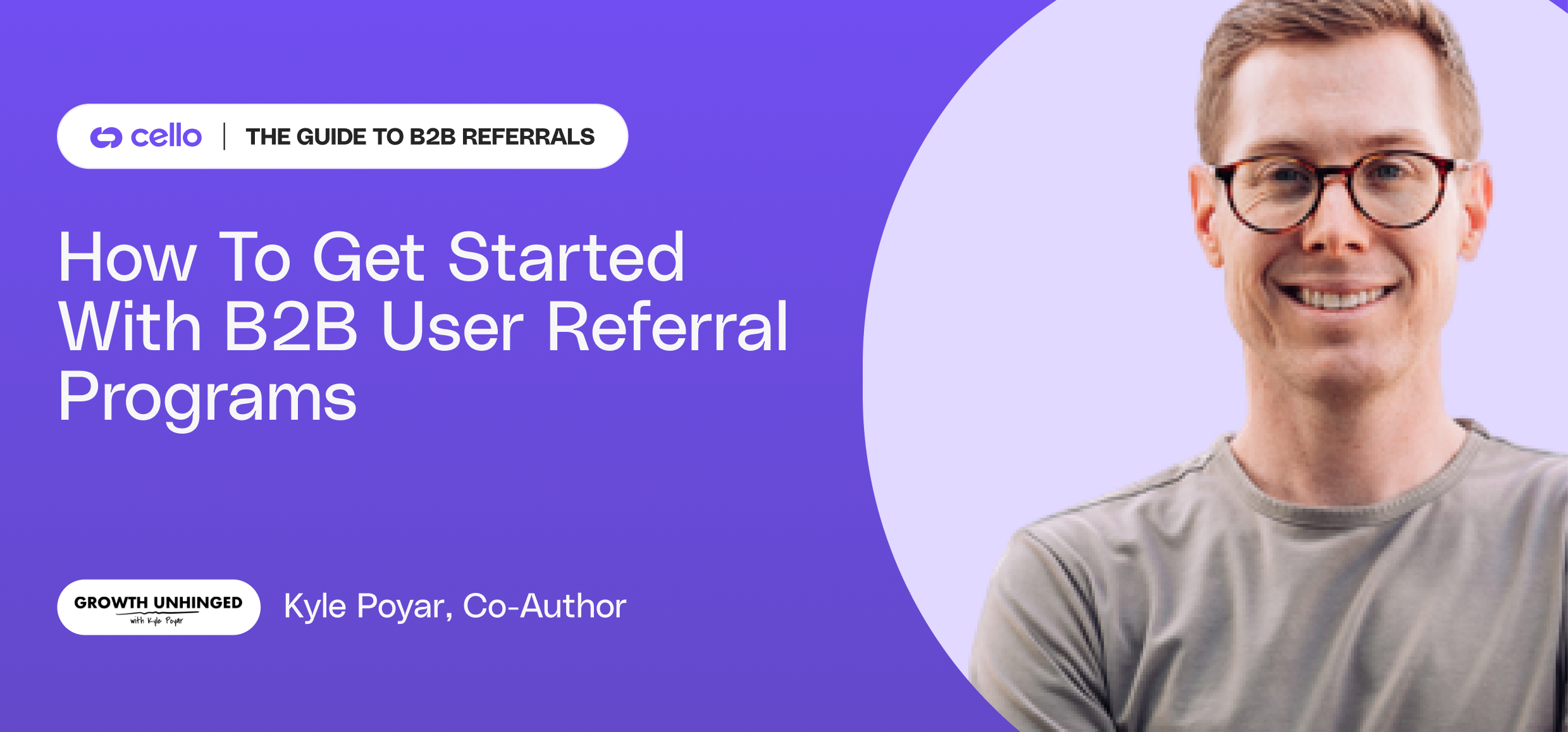TL;DR
- Word-of-mouth already outranks paid, search, and outbound for top SaaS firms; a structured B2B referral program lets you weaponise that advantage.
- High ACV and fast time-to-value make B2B rewards more lucrative than in B2C, but incentives must feel personal, two-sided, and revenue-linked.
- Embed referral triggers across the entire user journey (onboarding, aha-moments, NPS 9/10, case-study completions) to keep impressions high without spamming.
- Launch in stages, A/B-test rewards, and automate KYC/tax to stay compliant at scale.
- Healthy programs see 5-15 % of active users sharing, 2–5 invites per referrer, and 25 %+ conversion from invite to paid.
Contrary to popular belief, B2B user referrals can be as effective as in the B2C space, generating hundreds of leads per month when following the latest best practices. Let us show you how. This guide extends the collaboration between Cello and Kyle Poyar and will help you understand how to set up a successful B2B referral program that is as successful as referral programs from PayPal or Dropbox. Let's start with the basics.
What is a B2B referral program?
A B2B referral program is a way for businesses to promote their products or services through word-of-mouth referrals. It involves rewarding existing users for referring new customers to the business. But why should you invest in B2B referrals even though it’s still highly underrepresented compared to B2C referral programs?
Why should I invest in a B2B referral program?
First off, B2B referral programs are a scalable and ROI-positive channel that can be run at an LTV/CAC ratio of 3:1 or higher. Plus, this channel is becoming increasingly important as legacy channels reach their peak and emerging channels face higher acquisition costs (Meta CPM +61% YoY, TikTok CPM +185% YoY).
Referred users are usually your best users
Best-in-class freemium SaaS companies can achieve conversion rates of over 30% from free to paid, which is up to 5 times higher compared to paid or higher-intent SEO efforts in these same companies. According to a recent study by Wharton, users referred by other users exhibit 25% higher spending, experience 18% lower churn, and have a 16% higher lifetime value.
There’s never been a better time to invest in growing your word-of-mouth
The way B2B software is being discovered is undergoing a shift, moving away from outbound and search methods and towards social and personal networks, also known as "dark social". However, this channel is often undervalued in B2B due to the difficulty in attributing its impact.
Particularly, referrals play a crucial role in kickstarting platform products, fostering growth in both demand and supply. Word-of-mouth is the most preferred channel by far among best-in-class SaaS companies (BCG B2B SaaS report).

Now, we know how important B2B referrals are. In the past, exceptional referral experiences were often custom-made, requiring extensive effort and management. However, with the advancement of B2B referral program software, implementing such experiences has become more accessible, requiring minimal engineering involvement.
Regrettably, many programs as laid out in our B2B referral program teardown never come to fruition due to their complexity, hindering self-building (with high user experience standards) and long-term management. We try to shed light on this obstacle and share B2B referral program best practices:
What you will learn
- Is a referral program for you?
- How do you incentivize your users to share your product?
- How do you set the correct referral program rewards?
- How to get a referral program live quickly?
- What are the most powerful stages to recruit referrers?
- How to build engagement and referral habits for users?
- How to scale your B2B referral program?
- What should a high-performing B2B referral program look like (Benchmarks)?

1. Is a B2B referral program for my company?
Despite the obvious benefits when done right, referrals are not for everyone. What are the must-have prerequisites for making referral programs work in B2B?
Your users are already brand advocates
To generate buzz, it is crucial to have a product that is truly worth discussing. The growth of referrals serves as an indicator of product quality, as it indicates users who are genuinely enthusiastic about the problem you are addressing.
Additionally, it is important to note that if your existing users are not willing or able to promote your product organically, no amount of incentives will be able to rectify this underlying issue.
“Referral programs work very well for certain kinds of products, particularly ones that are already spreading via word-of-mouth." (Andrew Chen)
Your users already have a network worth sharing
Having a network of contacts is essential for your users to reach out and refer others. While some B2B products are as easy to refer as consumer products, many B2B products are more specialized and require extra effort.
Different from B2C, where almost everyone knows a handful of potential referrals, B2B sometimes offers a different advantage. Additionally, in the B2B landscape, the number of individuals who might be interested in a new AI writer tool is often larger than those I personally know who may need an HR solution. Implementing incentives can encourage your users to expand their network and connect with relevant users beyond their immediate circle.
Your users care about the rewards
As a user, it is important to genuinely care about the incentives. In-product rewards and discounts may not hold much relevance to an individual when the company is footing the bill. To entice busy professionals to take time out of their hectic schedules, rewards should be personally meaningful and compelling.
Another factor to consider is the Annual Contract Value (ACV) of your product. Monetizing your product is crucial. While B2B referral programs may not generate high user numbers, they offer the advantage of higher ARR per successful referral. In step 3, we will delve deeper into the topic of rewards.
Besides having a strong word-of-mouth presence and a remarkable product, the product's ACV and the speed of delivering its value (aka the aha-moment) play pivotal roles in determining the success of a B2B referral program.

You can position your company within the Referral Potential Venn diagram
Apart from the essential factors mentioned earlier, there are three additional dimensions to consider. Top performers excel in all three areas, but success can still be achieved by focusing on just two. Anything outside these optimal ranges is known as the "B2B referral program death valley."
Here's a simple way to determine if user referrals can work for your B2B SaaS business:
1. High Product Lifetime Value (LTV):
By setting higher rewards (e.g., through high ACVs), referrer engagement can potentially increase. However, there might be a downside of reduced new users within the referrer's network.
2. Fast Time to (Product) Value (TTV):
Streamlined onboarding processes, a clear value proposition, and quick results create a low-friction way for potential new users to experience the value of the product or service. This leads to faster referral habit formation since referrers can gain their rewards more quickly.
3. High Level of Product Engagement:
Maximizing referral potential involves aiming for a high number of daily users across the entire company. Engaged customers become enthusiastic advocates, driving more referrals.
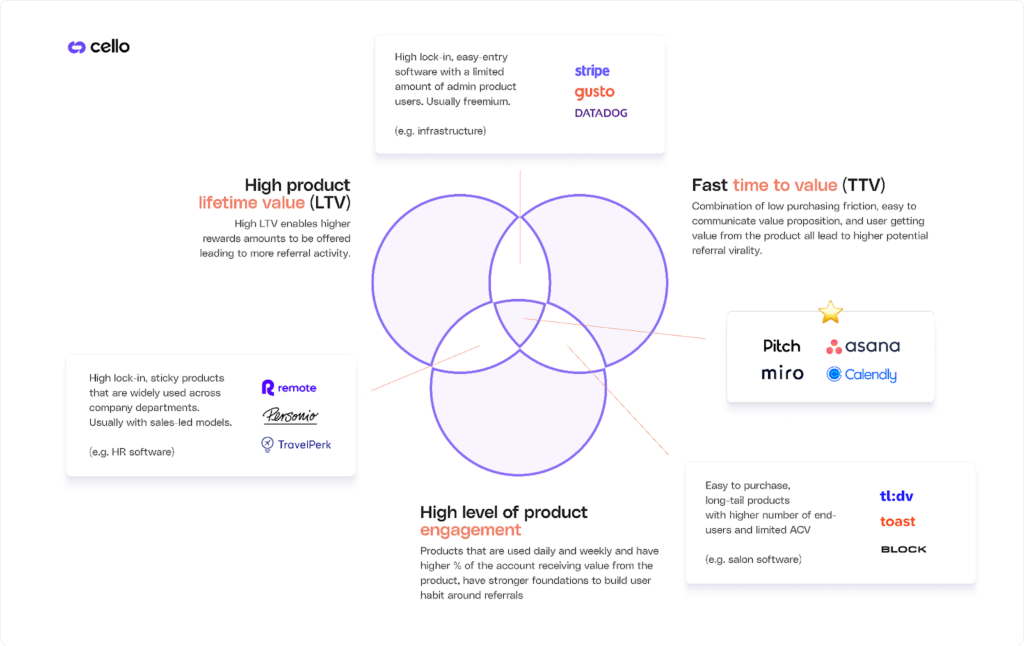
2. Embed program along your user journey
To offer a seamless experience, sharing should be easily accessible alongside the beloved features, catering to affiliates, micro-influencers, and regular users alike. It should effortlessly blend as a natural extension of the product. Eliminate hassles and say goodbye to unnecessary application processes and waiting periods when referring. This approach results in program discoverability and reduces participation friction. Below are some key considerations:
- Deliver timely referral nudges to your primed users through in-app messaging, prioritizing it over email or social media.
- Minimize the need to navigate users away from your product or engage in external signup flows to maximize program engagement.
- Think carefully about the order of steps requiring authentication or personal details. By providing rewards upfront, you can increase participation while reducing the necessity to gather user information at the onset.
- Incorporate both a referral mechanism and rewards system seamlessly within your product, without distracting users from their primary objectives. Strive for harmonious coexistence to enhance the user experience.
3. How do I set the right B2B referral program incentives?
Setting the right referral scheme can be difficult and relies on various factors (e.g. nature of product, ACV etc.). What we often see in B2B SaaS companies are in-product only rewards, which might lead to lower engagement and motivation in participation of the program. Below, we listed key requirements you need to nail when it comes to rewards.
1. Reward needs to be meaningful
B2B offers the opportunity for significantly higher rewards, thanks to the higher Annual Contract Value (ACV) of the products involved. However, it's essential to create appealing incentives that outweigh any hesitation in sharing (specific to each product). Our recommendation is to start with your ACV and work backward to determine the headline number that your users will see. We refer to this as the "reward cap" - the maximum earning potential per referral. For example, you could set a percentage of Monthly Recurring Revenue (MRR) up to a limit, such as $10,000. It's essential to have flexibility in your reward structure, as different people are motivated by different factors. Experimentation is key to determining the most effective approach for your product.
A recent study that we conducted with 100 SaaS users shows two main conclusions:
- Higher product ACV correlated with higher expected rewards by referrers
- Cash is king, but motivations other than cash matter in B2B as well
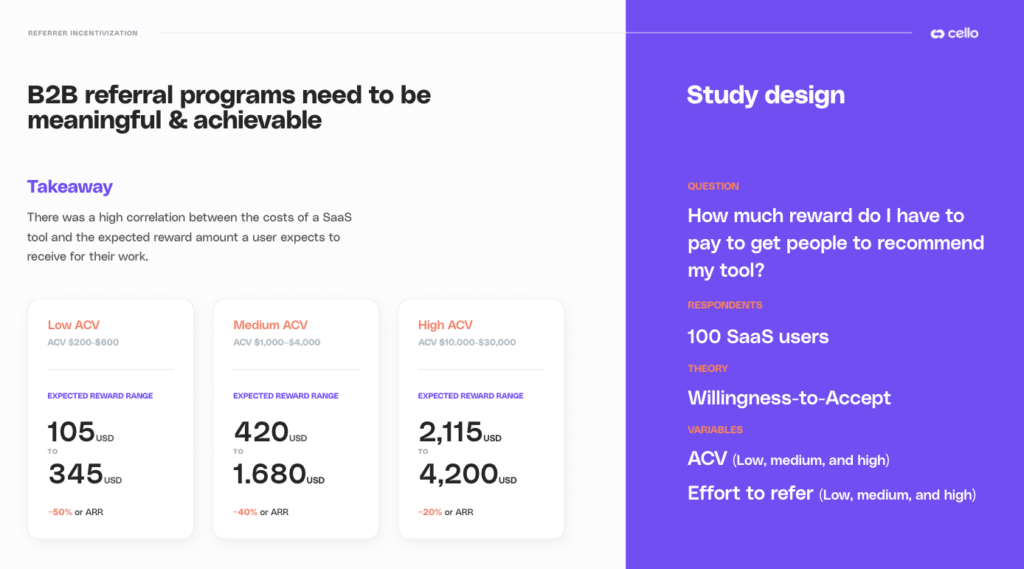
2. Rewards need to be multi-sided
A common mistake is to entice the referring users with rewards that only benefit them. When it comes to incentivizing invited users, it's crucial to offer tangible rewards. As emphasized by Andrew Chen, the key is to prioritize new external users and ensure the incentives are as enticing as possible. Discounts are particularly powerful and easily comprehensible, especially for products that offer rapid time-to-value, free trials, or have aggressive monetization strategies.
“I’ve also seen B2B contexts where in a professional setting, people tend towards inviting more if they are perceived as altruistic, giving out a large $ discount to others.” (Andrew Chen)
3. Rewards need to be personal
Direct monetary rewards, such as cash, generally yield the best results for most individuals. However, in B2B scenarios, it is crucial to personalize rewards in order to motivate stakeholders who may not be directly responsible for the associated expenses. Although in-product rewards, like Dropbox storage, can be impactful (esp. in the B2C context), it's important to acknowledge that not everyone has access to such offerings. While these rewards can be cost-effective, it's essential to consider that individuals who are unfamiliar with your product may not fully grasp their value.
Airtable rewards referrers with account credits. As a B2B user, this incentive could be more powerful as marginal cost-savings for the company the referrer is working with isn’t as attractive as earning this money for him or herself. Contrast this with tl;dv where the reward is both two-sided and much more attractive.

4. Rewards should encourage habit creation around sharing
B2B products typically have lower user numbers compared to B2C products, making it challenging for programs to sustain themselves in the long run. However, there are strategies to overcome this obstacle. One approach is to leverage the potential of individual referrers and transform them into brand advocates. By incentivizing their ongoing influence over an extended period, they can be rewarded for their efforts. Another advantage of B2B is the higher contract values it offers. This allows for the distribution of rewards across a longer duration as a percentage of monthly subscription payments. These recurring payouts serve as a powerful reminder, keeping referrals top of mind and motivating users to share with others, ultimately building a steady revenue stream.

5. Rewards should mostly be linked to generated revenue
While always feasible or ideal, opting for this approach is highly desirable as it offers inherent fraud protection and eliminates the payback period entirely. However, it is recommended to further explore rewarding intermediate milestones prior to generating revenue, as it can significantly expedite the referral process.

6. The way you communicate your reward matters
Ensure your users don't have to puzzle or strain their minds to grasp the potential earnings. Instead, use a reward cap that includes one-time rewards for qualified, free signups or demos, as well as a fixed percentage of the monthly recurring revenue (MRR) generated by referred users who become paying customers.
Uber employed a clever tactic by combining two distinct numbers to make an impact. They bundled the initial signup conversion with the earnings from the first month, as long as the driver completed a certain number of trips in the first few weeks. This approach resulted in a headline number of over $3000, a substantial upgrade from the initial $200 figures they started with. Unsurprisingly, these larger headline numbers consistently outperformed the smaller ones in rigorous A/B tests.

Presentation matters when it comes to influencing user behavior. By highlighting larger numbers and emphasizing tangible benefits, you can effectively sway user decision-making. Take a page from Amazon's playbook and start by crafting a compelling message that captivates and engages the end user. Consider what will grab their attention and encourage them to share.
4. Make sharing easy and effortless for your users
Getting users to discover your program and become hooked by your incentive is wasted if the effort of crafting messages or posts is too high. Make it easy for your users to craft great ads for your product.
1. Provide useful resources (Creative, copy, GIFs, explainers…)
Valuable resources to streamline user efforts: Offer swipe copy that referrers can easily customize to highlight key value propositions focused on acquisition. Remember to include social proof, such as testimonials or examples of how others have saved significant time by leveraging these resources. Include a clear call to action (Example of tl;dv).

2. Create a landing page where users can find out about your program
This is where you can include many of the above assets. Maintain an FAQ that you keep up-to-date based on the user feedback you’re receiving.

3. Give examples of what great referral messages look like
Ensure that your users can effortlessly articulate the clear value proposition of your product to others (Example of Butter).

4. Don’t forget to make it easy for users to know who you would like them to refer
If your ideal customer profile is not well-defined or if you are receiving a lot of leads that are not a good fit, you can provide instructions on the kind of users who would benefit the most from your product. For instance, products like Gusto have the capability to scan your contacts and recommend leads that are a good fit based on the email domains.

5. How to launch a B2B referral program like a pro?
The goal here is to maximize the number of impressions about the referral program without coming across too pushy. Repeat the pitch at every touchpoint, highlighting the incentive, and don’t rely on one-off campaigns (Lenny Rathitsky).
1. Rollout in stages
Consider the user segment you want to target: all users, a specific sub-segment, or influencers? When rolling out your referral program, it's advisable to do it in stages, if possible. Starting with your community of power users is ideal. They are generally more forgiving and provide valuable feedback that can help improve the program for others.

2. Go-Live campaign (existing users)
Referral programs in B2B are a long-term game, so it's essential to have a multi-channel approach. You'll need a campaign to create awareness among your existing users and attract influencers. Key channels to consider are
- email sequence (standalone or as part of a newsletter or product release)
- in-app messaging (standalone or part of a wider lifecycle sequence)
- social media announcements (great for reaching influencers and affiliates who may not actively use your product)
- linking from your homepage (and ensuring the page is indexed)
- including referral information in bios and email signatures
- leveraging your community
- and optionally exploring PR opportunities
Remember to keep repeating your message across all channels and adjust the messaging as you go.

3. Onboarding and referrals (New users)
Think about your new user journey and consider the moments when excitement is at its peak and users are most likely to share. These moments include when users reach their "aha" moment, immediately after inviting a team member, and as part of the onboarding email series. If your product has a low activation rate, it's advisable to target new users shortly after signup, before they have a chance to drop out.

The headline best practice is that your referral program should target new users to refer their friends — this means prompting users during their initial onboarding flows, and adding emails as part of the onboarding, among other surface areas (Andrew Chen).
4. Behavioral triggers (Existing and new users)
Consider touchpoints as steps in the journey when excitement is high. These touchpoints include:
- filling out an NPS survey with a score of 9 or 10
- reaching the end of successful customer service engagements
- sharing links/documents externally
- achieving product milestones
- incorporating them in transactional emails that showcase the value received from using the product
- completing a case study

5. Consider post-launch activities
The referral program will likely not be perfect the first time around. To gain insights into how users perceive and value rewards, engaging in conversations with them is crucial. By understanding their friction points that hinder sharing, we can identify the appropriate rewards to offer.
You need to A/B test. When using vendors or deciding to build your own system, it's crucial to consider flexibility. This includes the ability to run campaigns in different geographies, conduct A/B testing for incentives, and customize the size and type of rewards offered. By employing these strategies, you can easily fine-tune incentives to maximize its potential. It's also important to identify the most effective communication channels for your users and to articulate the benefits of the rewards clearly. Focus not only on what there is to gain, but also on what you can offer.
6. How to deal with B2B referral program legal requirements?
Referral programs are about scaling. Have a plan to ensure KYC, legal and tax compliance, an often overlooked aspect. Something to keep in mind when deciding between self-building vs. selecting a vendor
1. No, you can’t and shouldn’t try to manage payouts in Excel and do them manually
If you decide to handle payouts manually, you'll also have the responsibility of managing KYC (which falls under Anti Money-Laundering laws, commonly known as AML) using payment gateways that are KYC-compliant. You will also need to respect specific payout thresholds to avoid trouble with your accounting team.
To ensure a seamless user experience, it is important to pay referrers in their respective currencies, although this may present challenges due to potential conversion issues.
2. Make sure you have sophisticated terms of service, don’t forget edge cases
Self-referrals are strictly prohibited. Referrers must refrain from falsely representing themselves as acting on behalf of your company. It is important to avoid running search, social media, or any other ads to prevent confusion. Keeping these guidelines in mind will help ensure a fair and transparent referral process.
3. Tax treatment for referrers who earn rewards depends on country-by-country regulations and has implications for you as the company that is making the payouts
Proper tax compliance involves informing referrers about tax implications, providing necessary documentation, and facilitating communication with tax authorities. Failure to address these aspects can result in significant overhead and hinder automation in the future.
If your business rewards users privately, it is highly recommended to educate referrers on how to handle this income from a tax perspective. Taking precautions will help you avoid potential legal issues.
Here are some important considerations:
- Referrers who act as suppliers need to report the referral income in their annual private tax return or corporate tax return, depending on their situation.
- Each country has specific tax reporting rules, including thresholds for sales generated through "self-employed" work. Crossing these thresholds may require referrers to register as a business or become VAT registered.
- Some countries may require businesses to provide specific information or report to local authorities, such as issuing credit notes. Make sure you understand and comply with these requirements.
Here are a couple of examples:
- In the United States, businesses are obligated to issue a year-end tax form to non-corporate referrers who receive $600 or more.
- In France, specific referrer data needs to be reported to the French Tax authorities annually.
By understanding and adhering to these guidelines, you can ensure a smooth and compliant process for both your business and referrers.
7. What are good B2B referral program benchmarks?
At the end of the day, it's important to assess both the quantity and quality of new users that the program is attracting. This can be measured through the participation rate, which represents the percentage of active users who have shared at least one referral. It's crucial to evaluate how effective you are at recruiting referrers from your existing user base. For tips on boosting this percentage, refer back to step 7 in the tactics section.
Measuring the reach generated by your referral program is essential. User referrals can serve as a potent brand-building channel. Most individuals have a following and engage in one-to-many sharing across platforms like WhatsApp, Slack, and LinkedIn. Evaluating the average number of invites sent per user is key to understanding the effectiveness of your program. It's essential to track the conversion rates from invited user visits to signups, as well as from signups to activations. Additionally, assessing your ability to onboard these new users is vital since they often require more activation energy and possess less knowledge about your product than users from other acquisition channels.

Learn more about B2B referral program KPIs and benchmarks here.
Conclusion
In this comprehensive guide to B2B referral programs, we've delved into the world of leveraging word-of-mouth marketing in the business-to-business space. If done well, B2B referral programs hold immense potential for generating new leads and expanding your customer base. Here are the key takeaways and the roadmap to creating a successful B2B referral program:
- Assessing Suitability: Before diving into a referral program, it's essential to evaluate whether it's a good fit for your business. Look for brand advocates among your existing users, consider their networks, and ensure your users value the incentives.
- Integration into User Journey: To make your referral program seamless and engaging, embed it throughout the user journey. Ensure that sharing is easy, accessible, and blends naturally with the user experience.
- Incentives and Rewards: Crafting the right incentives is crucial. Rewards should be meaningful, multi-sided, personal, and encourage habit creation around sharing. Tailor the incentives to your specific product, its ACV, and your users' preferences.
- Sharing Made Easy: Simplify the process of crafting referral messages and posts. Provide users with resources, landing pages, and examples of effective referral messages. Make it clear who your ideal referrals are.
- Legal Compliance: Scaling a referral program comes with legal responsibilities. Ensure compliance with KYC, tax, and other legal requirements. Have clear terms of service and educate referrers on their tax obligations.
- Launching Like a Pro: Plan your program's launch strategically. Roll it out in stages, target specific user segments, and utilize a multi-channel approach to create awareness among existing and new users.
- Post-Launch Activities: Continuous improvement is key. Engage with users, A/B test your program, and adapt based on user feedback. Fine-tune incentives and communication channels for maximum efficiency.
- Benchmarking Success: To measure the success of your program, track participation rates, the reach generated, and conversion rates from referrals. These metrics will help you evaluate the impact of your B2B referral program.
What is a B2B referral program?
A structured, trackable way to turn satisfied business users into advocates who bring in new customers, typically in exchange for rewards.
Why should my company invest in referrals when we already run ads and SEO?
Referral programs can deliver an LTV/CAC ≥ 3:1, generate highly engaged leads with up to 30 % free-to-paid conversion, and outperform paid channels as ad costs rise.
How do I know if referrals will work for my product?
Check the “Referral Potential Venn”: (1) high LTV/ACV, (2) fast time-to-value, (3) strong day-to-day product engagement. Hit at least two—ideally all three.
What prerequisites should be in place before launching?
Users already rave about you. They have relevant networks. Rewards matter personally to them. Your product has clear aha-moments you can surface quickly.
Where should I surface the referral call-to-action?
Embed it natively along the user journey: in-app menus, post-aha modals, NPS “9–10” screens, onboarding emails, and usage milestones—before resorting to standalone pages or email blasts.
What incentives work best in B2B?
Start from ACV and back-calculate a compelling “headline” cap (e.g., % of MRR up to $10 k). Cash is king, but combine cash with discounts or product credits so both referrer and invitee win.
How can we make sharing effortless?
Give swipe-copy, pre-made creatives, GIFs, and a dedicated landing page with an up-to-date FAQ. Show sample posts and clarify the ideal customer profile to cut mis-targeted leads.
What legal and tax hurdles should we prepare for?
Automate Know-Your-Customer (KYC) checks, use compliant payout rails, draft airtight terms banning self-referrals/paid ads on your brand, and educate referrers on local tax obligations.
Resources
Related articles
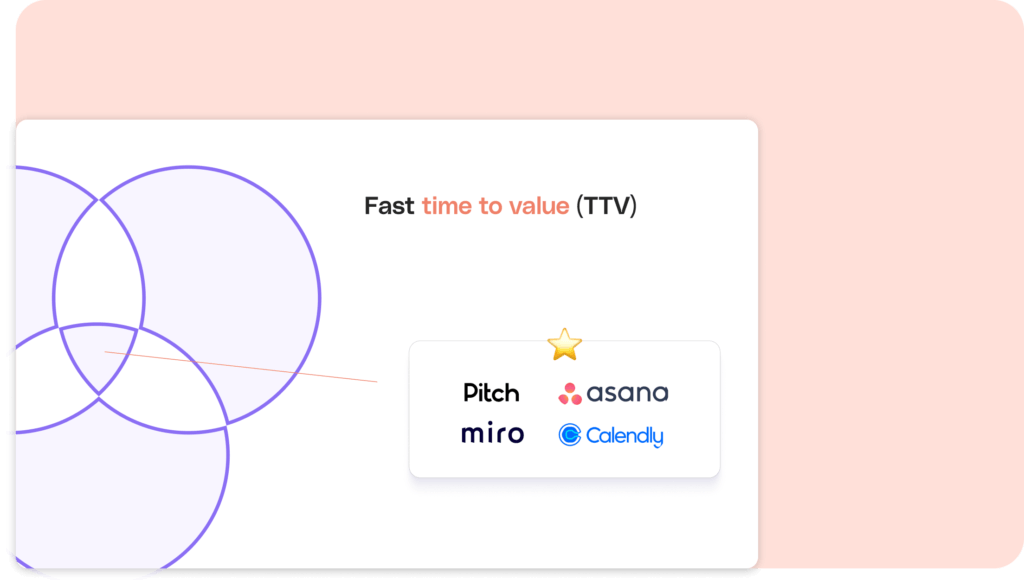
B2B Referral Program Examples
Uncover B2B referral program examples and learn from best practices how other companies utilize ...

B2B Referral Program KPIs (2023)
Dive into the world of B2B referral program KPIs & benchmarks. Explore successful program ...
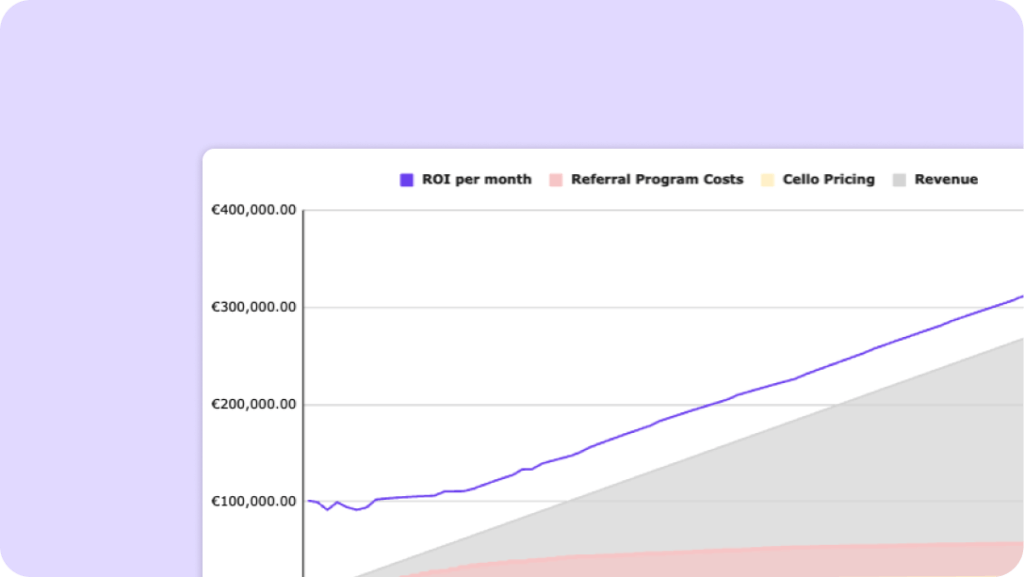
PLG SaaS Referral ROI Calculator
Learn how to estimate and prove the ROI of your PLG Referral Program
